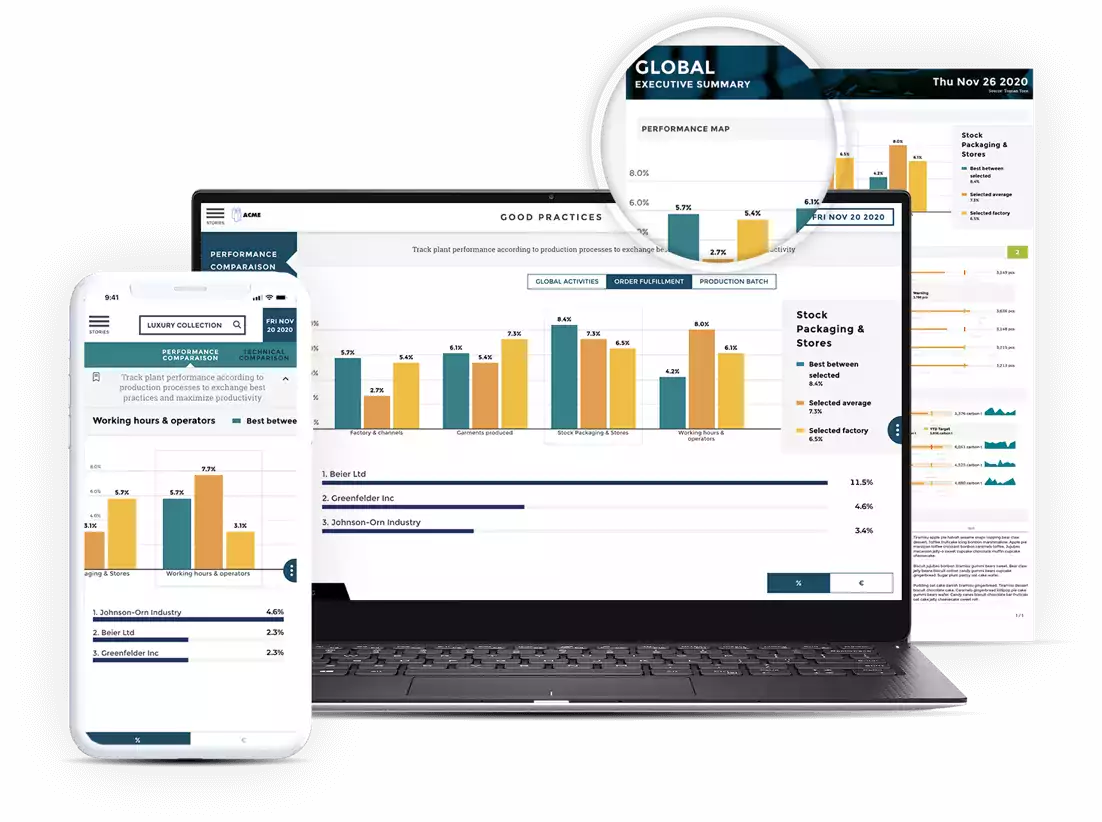Data analysts all face this daily situation: as they work on long-term analytics projects, they are repeatedly interrupted by Dan from Sales asking why there’s an uptick in cart abandonment, and then Sally from Marketing wondering why the Instagram account gained so many followers.
And as the day goes by, you end up spending more time answering to their requests rather than focusing on projects that matter.
And yet, providing your team with this specific data to answer in-the-moment questions is an absolute game-changer to create adaptability in a fast-paced company world. This is the very principle of ad hoc analysis.
But, as all BI analysts are aware, this process can be really exhausting.
What if we told you this day-to-day struggle could come to an end with a better management of ad hoc analysis requests?
Let’s explore what ad hoc analysis is and how companies can harness its power for strategic success.
-1.png?width=600&height=403&name=Report%20(ALTERNATIVE)-1.png)
Table of contents
- What Is Ad Hoc Data Analysis?
- Why Ad Hoc Analysis Is Key To Business Success Today
- Facing The Challenges Of Ad Hoc Analysis
- Step Into The Future Of Seamless Ad Hoc Analysis
What is ad hoc data analysis?
Let’s start with a quick Latin lesson: “ad hoc” means “for this” or “for this specific situation”, indicating something designed for a specific purpose or task rather than for general usage.
When used in the context of "ad hoc analysis," it refers to analysis conducted for a specific, often one-time, question or problem.
This kind of analysis is not part of regular, scheduled reporting but is performed as needed to address immediate, unique, or unforeseen issues. In other words, it is conducted on an as-needed basis to address specific and immediate business needs.
Three real-life examples of ad hoc analysis

1. Financial performance review
The CFO of a company wants to understand the reasons behind a recent unexpected drop in profit margins.
To address this particular issue, it is required to investigate the factors contributing to the decrease in profit margins, focusing on revenue, costs, and operational efficiencies.
The data analysts should gather financial data including income statements, balance sheets, and detailed reports on revenues and expenses from the period of interest.
This ad hoc analysis allows to highlight the main drivers behind the reduced profit margins and help the CFO make a data-based decision to tackle this issue.
2. Post-event evaluation for a corporate conference
Following a major corporate conference, the organizing team wants to evaluate its success in terms of attendee satisfaction and engagement to improve future events.
This involves collecting feedback from attendees, analyzing social media engagement, and examining session participation.
By assessing this data, the team aims to understand overall satisfaction, identify the most engaging topics and speakers, and pinpoint areas needing improvement.
The insights gathered offer valuable guidance for enhancing future events, suggesting adjustments in content and logistics to better meet attendee expectations and elevate the event experience.
3. Social media sentiment analysis for brand
A brand manager noticed a lot more people were talking about their brand on social media and decided to take a closer look to understand why.
Using social media monitoring tools and natural language processing techniques, the analysis distinguished between positive, neutral, and negative sentiments, aiming to identify if the spike was due to a marketing win or a PR issue.
This process helped figure out if the sudden increase in chatter was because of a successful ad campaign or maybe a problem they needed to fix.
By understanding what people were saying, the brand manager could make better decisions on how to improve the brand's image or keep up the good work.
Why ad hoc analysis is key to business success today
In a fast-paced and data-driven business landscape, ad hoc analysis has become a must-have tool for companies aiming to maintain a competitive edge.
It helps you understand the “why” hiding behind unusual business metrics, which is fundamental to navigate your business’ strategy and decisions.
As it will drive some of your most important decisions, it will also bring you a set of other life-changing advantages.
1. Improve exploration of data
You get it now: ad hoc analysis allows businesses to delve deeply and flexibly into their data whenever new questions or challenges arise.
This flexible approach breaks away from the constraints of regular reports, enabling a tailored examination of specific issues or opportunities.
By facilitating customized exploration of data, businesses can focus on the specific variables and relationships that matter most at any given moment.
2. Build a data-driven corporate culture
Not every company is inherently data-savvy, and that’s okay. However, ad hoc analysis seeks to elevate the game by empowering team members to self-serve for analytics.
It doesn’t mean they should become data scientists, but rather that they should access basic tools to get the answers they need.
By empowering teams and individuals with these tools and mindset, you encourage them to make decisions based on evidence rather than intuition alone.
This analytical approach creates curiosity, critical thinking, and a willingness to explore data spontaneously to answer specific, often unexpected questions.
In short, it democratizes data access across the organization, leveraging the collective intelligence of the entire company.
When given the right tools, all the employees can then run their own ad hoc analysis. This is why self-service BI platforms such as Toucan have become more and more popular. They offer a better user experience and no code features, allowing employees to easily connect, explore, and visualize company data.
3. Keep up with change
Companies never stop evolving. Where new products are sold, new marketing campaigns are launched, and new events are organized, there is a potential ad hoc analysis.
In a world where market dynamics shift rapidly, the ability to quickly pivot and adapt strategies based on real-time data is precious.
Ad hoc analysis empowers companies to not just react to these changes, but to proactively address emerging trends, challenges, and opportunities.
This agility, being able to sift through, understand, and act upon the latest data, ensures that a company is not just keeping up with change but is also prepared to lead and innovate. It leads to comprehensive decision-making based on real-time insights.
4. Complete the dashboard solution
Ad hoc analysis is all about immediacy. However, you may later realize that the very specific data you needed a few months ago is actually useful on a long-term basis.
Our perspective is that while ad hoc analysis is primarily meant for now, in the present,- it can also serve as the foundation of your standardized reports.
It helps you identify which data points are most valuable, guiding the development of regular reports tailored to your organization's needs. Ultimately, it enables employees to better engage with and benefit from standardized reports.
Facing the challenges of ad hoc analysis
In an ideal world, ad hoc analysis would provide instant, precise answers to any data question, making expert-level insights accessible to all with the ease of a conversation.
In the real realm of business, establishing this mindset and making the process smooth for every employee is a bit more complicated. It requires an in-depth change within the whole company to avoid common issues related to ad hoc analysis.
Here are a few mistakes many tend to make when trying to implement this approach (and the pitfalls you should avoid at all costs).
Overloading analysts with only ad hoc requests
Ad hoc analysis requests should not only depend on the data team. Too often, BI analysts spend most of their time responding to one-off, urgent inquiries, creating a reactive environment where long-term planning and analysis are sidelined.
This constant firefighting mode means that analysts have less time to engage in deeper, more thoughtful analysis that could uncover underlying trends, inefficiencies, or opportunities for innovation that are crucial for strategic growth.
Not to mention that most people have a poor framing of what is and what isn’t an ad hoc question. Not every data-relative question is an ad hoc analysis. This confusion can make it even harder for data analysts to juggle the number of requests.
💡 How to face the issue →
- build a solid data culture to allow everyone to run ad hoc analysis and find immediate answers to their questions.
- Allocate resources to train the employees to reduce the strain placed on the data stream.
- Use self-service analytics with better data visualization and user experience so that everyone can easily find data.
Creating bottlenecks in the data analysis process
Each ad hoc analysis request might need unique data sets that aren't readily available or prepared for analysis. Gathering, cleaning, and preparing this data can be time-consuming, especially if data governance practices are not strong or if data is siloed across the organization. This preparation phase can significantly slow down the analysis process.
Ad hoc analysis also often lacks the standardization present in routine analysis workflows. It means that BI analysts might have to create new scripts or queries from scratch for each request, rather than relying on a library of existing, optimized tools and templates. The need to reinvent the wheel for each request adds to the time and effort required.
💡 How to face the issue →
- Use a ticketing system to filter requests and prioritize the highest-value reports.
- Build a process from initiation to delivery to save time and avoid repetitive requests.
Addressing repetitive requests
Tackling the same ad hoc requests over and over can feel like being stuck in a loop for data teams, eating away precious time and energy that could spark real innovation. This repetition not only wears down analysts, risking burnout and mistakes, but also shackles an organization's ability to dive deep into its data treasures for groundbreaking insights.
💡 How to face the issue →
- Set up standardized reports for frequent queries: by identifying common requests, you can pinpoint the need to transform certain ad hoc analysis into dashboards.
- Implement self-service analytics.
Want more tips on how to handle these requests? Discover our best practices for managing ad hoc reporting requests.






